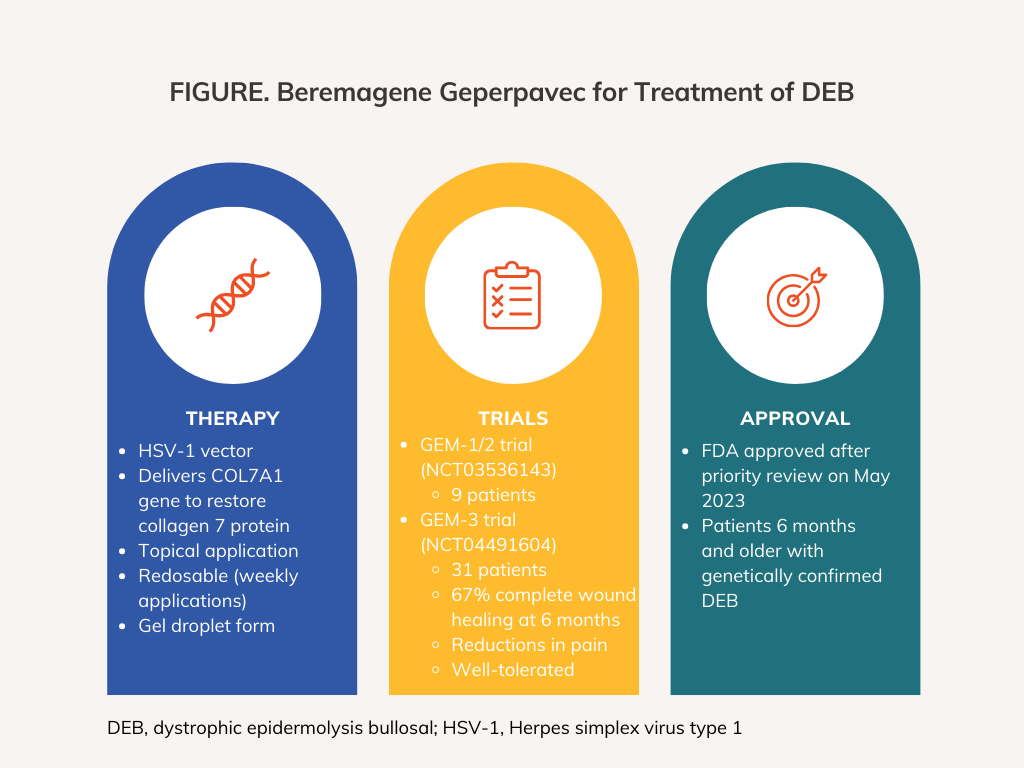In a landmark event in May 2023, the FDA approved Krystal Biotech’s beremagene geperpavec (B-VEC) under the name Vyjuvek for the treatment of dystrophic epidermolysis bullosa (DEB), making it the first approved gene therapy in the dermatology field.1 As we reach 6 months out from the therapy’s approval, CGTLive spoke to experts in the field about their experiences and impressions of B-VEC as well as future questions and research needs that remain.
“I've been prescribing it to a number of patients, and they have been really enjoying its use and are seeing healing of their skin... Up until now, EB patients had no corrective therapy at all. It was frustrating for the patients, families and physicians alike. We were able to use fancy wound dressings, fight infection, and try to promote nutrition, but we just helplessly watched the blisters form and couldn’t do anything about it... They've all been waiting for such a long time for this. It's just so exciting to get a corrective therapy to them,” M. Peter Marinkovich, MD, an associate professor of dermatology at Stanford University, and an investigator on the GEM trials, told CGTLive.
B-VEC differs from other gene therapies in that it is topically applied in a gel droplet form to the skin and redosable, with caregivers applying it to wounds on a weekly basis. Rather than using an adeno-associated virus vector, it is a herpes simplex virus type 1-based gene therapy that delivers COL7A1, mutations in which cause DEB, to restore collagen 7 protein. COL7 molecules are arranged in long, thin bundles that form anchoring fibrils that hold the epidermis and dermis together, which helps maintain the integrity of the skin. The gene therapy has also been modified so that it does not replicate in normal, unaffected cells (FIGURE).
"[We need more time] before we can truly see the full impact [but] we anticipate it to be incredibly important. Some of the people that have been on this therapy for a number of years have really seen a huge positive impact on the quality of life - from being wheelchair bound to no longer, from bath and bandage time going from 4 hours to a half hour - I'm very, very enthused by the impact that this therapeutic agent is going to have on the EB population," Brett Kopelan, MA, the executive director of the Dystrophic Epidermolysis Bullosa Research Association (debra) of America, told CGTLive.
B-VEC - A First of its Kind Approval
B-VEC's approval was supported by data from the phase 2 GEM-1/2 (NCT03536143) study and the phase 3 GEM-3 study (NCT04491604). GEM-3 was a double-blind, intra-patient randomized, placebo-controlled trial in patients at least 6 months of age with genetically confirmed DEB. The trial assessed healing between B-VEC treated and control treated wounds in selected wound pairs.
WATCH NOW: Alfonso Sabater, MD, PhD, on Treating Ocular DEB With B-VEC
“It's the first topical gene therapy, the first redosable in vivo gene therapy, as well. There are a lot of cell-based therapies that require a lot of cell manufacturing and a very specialized facility to place these therapies, but with this therapy, it's very easy. Just put it on the skin,” Marinkovich said.
A full data readout from the GEM-3 study was published in the New England Journal of Medicine in December 2022, and demonstrated a 67% rate of complete healing at 6 months in treated wounds in 31 patients, compared with 22% of those not treated with B-VEC (difference, 46%; 95% CI, 24-68; P = .002).2 At 3 months, 71% of wounds treated with B-VEC were completely healed compared with 20% exposed to placebo (difference, 51%; 95% CI, 29-73; P <.001). Pain severity during wound-dressing also decreased by 0.88 points from baseline to week 22 in B-VEC-treated wounds and by 0.71 in placebo-treated wounds, (adjusted least-squares mean difference, −0.61; 95% CI, −1.10 to −0.13). The gene therapy was well-tolerated, with common adverse events (AEs) including pruritis and chills.
“One of the things that's really attractive to me about this therapy is its potential for use in underserved communities and underdeveloped countries, because it's so easy to use... I'm excited about the future for this therapy.”
- M. Peter Marinkovich, MD
The Dermatological Outlook
Following the landmark approval, the field will undoubtedly continue to change over the coming years. Kopelan predicted that care of DEB will shift from a predominantly pediatric population to include more of the adult population as standards of care improve and more novel therapies come to market. debra of America stands poised to support such a shift and is focusing on preparing physicians and centers to handle it.
“With the amount of therapeutic agents that are coming down the road, that are in the regulatory pathway and in development, I can see patients getting to the point of being able to live totally normal lives, as we make this disease a chronic but livable disorder,” Kopelan said.
In addition to a shift in patient population, Marinkovich’s future predictions centered on how centers of care for DEB will adapt. With the ease of application of B-VEC and possibly other future therapies, specialized centers will become less important and local community centers, pediatricians, and dermatologists will get more involved with DEB patients in their local communities.
“It is going to change the dermatology field. Up until now, gene therapy was just a research tool. But now, it's something that's becoming integrated into clinical practice. It'll give dermatologists a chance to be able to start practicing gene therapy and it’s a brand-new area for all the young dermatologists getting into the field,” Marinkovich said.
Future Areas of Research
Marinkovich also posited that treatment of DEB will expand to patients younger than 6 months, the limit assessed in trials and the currently approved population. He is looking forward to seeing continued positive safety data that will allow the cutoff to be pushed even younger, to possibly get ahead and prevent long-term complications often seen in older patients with DEB. Marinkovich also expects to see more research done with the therapy’s HSV-1 vector and considers its use to be the most important research advance to come out of the approval.
“HSV-1 just naturally has this ability to evade the immune system. … if you have a disease, it's not a good thing, but if you have a gene therapy, then it's really a useful breakthrough. I would expect that there's going to be a number of other researchers and clinical trials utilizing HSV-1 in the future,” Marinkovich said.
Further data that Kopelan is looking forward to involves debra of America’s patient registry, launched in partnership with LunaDNA in October 2023.3 The registry will allow individuals with EB to safely aggregate their electronic health records, and data from it may inform drug development and facilitate studies under the accelerated approval pathway.
“Right now, the FDA really only uses 100% wound closure as a clinically meaningful endpoint. We want to look for other endpoints that may be better accessible for drug development, and thereby helping our patient community in the long run much better and more efficiently,” Kopelan said.
Expanding Ophthalmic Use of B-VEC
Clinical Takeaways
- B-VEC gene therapy, approved by the FDA in May 2023, offers a topical and redosable treatment for dystrophic epidermolysis bullosa (DEB), a significant advancement in dermatology.
- Clinical data from the GEM-3 study shows B-VEC's efficacy with a 67% wound healing rate at 6 months and reduced pain during dressing changes, improving the quality of life for DEB patients.
- With B-VEC's ease of application and positive outcomes, dermatology is transitioning toward integrating gene therapy into clinical practice, offering new possibilities for treating various skin conditions.
Another avenue of future research comes from a wholly different field but with precedent – ophthalmology. Out of the 40 patients that received topical B-VEC throughout the GEM-1/2 and GEM-3 trials, 1 patient also received an ophthalmic formulation of B-VEC under a compassionate use approval. The patient was treated in one eye for recurrent cicatrizing conjunctivitis, which was an ocular complication of his DEB. B-VEC was associated with full corneal healing by 3 months and significant visual acuity improvement from hand motion to 20/40 at 7 months.4 It was well-tolerated with no treatment-related AEs.
Given this initial success with 1 patient, cornea specialist and treating physician in the compassionate use program, Alfonso Sabater, MD, PhD, the medical director of the Ocular Surface Program and of the Corneal Innovation Laboratory at the Bascom Palmer Eye Institute of the University of Miami Miller School of Medicine, looks forward to being able to assess the ophthalmic formulation of B-VEC in more patients with DEB or other severe and refractory eye conditions in which delivery of COL7A1 may help.
“We are definitely very interested in treating additional patients that may have this condition but also treating other conditions in the eye that maybe have a genetic component, or even ones that don’t. So, we are exploring other options using the same viral platform not only to treat patients with DEB but potentially treat other patients with complex and severe conditions that have no cure where maybe collagen could play a role,” Sabater told CGTLive.
REFERENCES
1. FDA approves first topical gene therapy for treatment of wounds in patients with dystrophic epidermolysis bullosa. News release. FDA. May 19, 2023. Accessed May 19, 2023. https://www.fda.gov/news-events/press-announcements/fda-approves-first-topical-gene-therapy-treatment-wounds-patients-dystrophic-epidermolysis-bullosa
2. Guide SV, Gonzalez ME, Bağcı IS, et al. Trial of beremagene geperpavec (B-VEC) for dystrophic epidermolysis bullosa. N Eng J Med. 2022; 387:2211-2219. doi:10.1056/NEJMoa2206663
3. debra of America launches registry for individuals and families diagnosed with "the worst disease you've never heard of" epidermolysis bullosa. News release. debra of America. October 4, 2023. https://www.prnewswire.com/news-releases/debra-of-america-launches-registry-for-individuals-and-families-diagnosed-with-the-worst-disease-youve-never-heard-of-epidermolysis-bullosa-301946449.html
4. Sabater AL, Tovar A, Gomez J, et al. Compassionate use of topical beremagenegeperpavec (B-VEC) for the treatment of recurrent cicatrizing conjunctivitis in a patient with dystrophic epidermolysis bullosa. Presented at: 2023 Association for Research inVision and Ophthalmology Annual Meeting, New Orleans, Louisiana; April 23-27.



